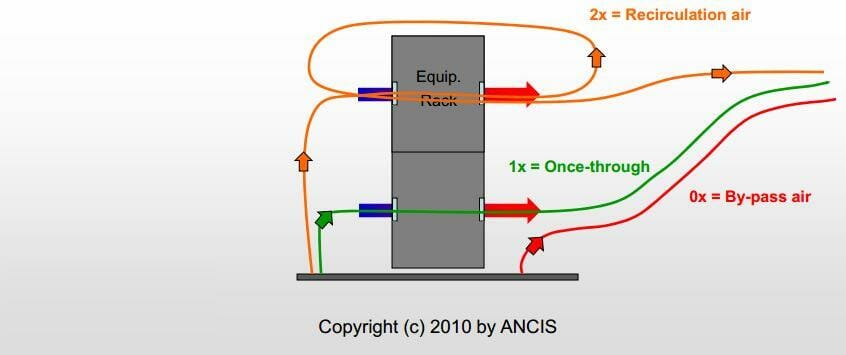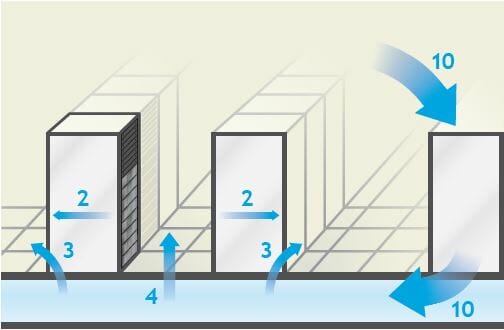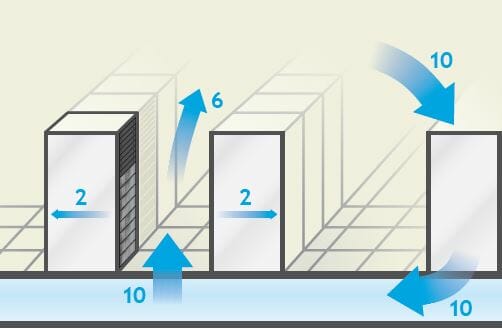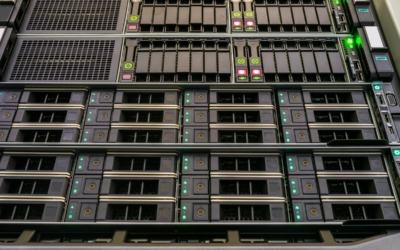Bypass Airflow: Not as Simple as You May Think13 min read

Increasing density and the pressure to save money in the data center are driving awareness towards the importance of improving airflow management. One of the most fundamental aspects of airflow management is bypass airflow. While airflow management best practices are becoming more well-known and better understood, bypass airflow and how to reduce it is less understood with several common misconceptions creating confusion. .
What is Bypass Airflow?
Before we take a look at the common misconceptions people have about reducing bypass airflow, it would be good to clarify what exactly we are referring to when we say, bypass airflow. By definition, bypass airflow is any conditioned air from a cooling unit that DOES NOT pass through IT equipment before returning back to a cooling unit. Another way to understand this is through the concept of “Once-Through Cooling”, coined by Magnus Herrlin. It means that each cold air “cluster” passes through the server equipment exactly one time (shown below).
In the illustration above, from Herrlin’s presentation titled Room-Level Energy and Thermal Management in Data Centers: The DOE Air Management Tool, you see that once-through cooling passes through the equipment rack only one time before returning to a cooling unit while recirculation air passes through twice. Bypass airflow on the other hand, does not pass through the equipment rack at all before returning to a cooling unit, hence bypass airflow.
Common Misconceptions
Bypass airflow is prevalent throughout the industry and often remains at sites even after initiatives to reduce it. The problem is not the non-acknowledgement of bypass airflow, but rather an understanding of how to reduce it. Below are common misconceptions about reducing bypass airflow:
1. Sealing cable openings will reduce bypass airflow.
2. Replacing perforated tiles or grates in a hot aisle or open space with solid tiles will reduce bypass airflow.
3. Installing blanking panels will reduce bypass airflow.
Although all of these methods are good airflow management initiatives and are necessary prerequisites to reducing bypass airflow, they alone do not reduce bypass airflow. In order to reduce bypass airflow, other steps must be taken after deployment of these initiatives. The following figures represent a simplified computer room with one cooling unit and two rows of cabinets.
Figure 1 illustrates a typical computer room that has not completed raised floor open area management. The cooling unit is supplying 10 units of cooling airflow volume. Unsealed cable openings are releasing a total of 6 units of volume, and perforated tiles in cold aisles are releasing 4 volumes of conditioned airflow. The IT equipment consumes a total of 4 units of volume. In this case the volume of air supplied by perforated tiles equals the volume of air consumed by IT equipment. The only bypass airflow in the room, 6 units, is air escaping from the unsealed cable openings.
Figure 2 illustrates the situation after the raised floor open area has been completely managed. Now the 6 units of conditioned air volume that were escaping through unsealed cable openings is also coming out of the perforated tiles properly placed in the cold aisle. So now a total of 10 units of air volume from the cooling unit reaches the cold aisle, but since only 4 units are needed by the IT equipment, 6 units of conditioned air volume leave the cold aisle as bypass airflow. This simplified example shows that changing the volume of conditioned air supplied by cooling units is the only way to change the volume of bypass airflow in a room.
Just to clarify, many sites have implemented airflow management best practices and seen benefits such as improved IT intake air temperatures and improved IT equipment reliability, among others, but there are still additional benefits that can be achieved. Changing cooling unit return air temperature set points, reducing fan speeds, or turning off excess cooling units doesn’t only reduce bypass airflow, but also increases cooling unit efficiency, increases cooling unit capacity, and reduces operating expense.
Conclusion
As the figures above have shown, sealing the openings in the raised floor that release bypass airflow increases the volume of conditioned air from perforated tiles and grates. This will likely eliminate hot spots and increase the IT load that can be cooled, however, the return air temperature to cooling units will not change. The return air temperature to cooling units, and therefore their efficiency and capacity, is a function of airflow volume, heat load, and the thermostatically controlled return air temperature set points of the units. Raising the cooling unit return air temperature set points increases the efficiency and capacity of cooling units.

2 Comments
Trackbacks/Pingbacks
- IT Equipment Delta T and Flow Rate: How They Impact Your Data Center - […] we discussed in our recent blog post, reducing bypass airflow is key to increasing cooling capacity and reducing operating…










Thanks. Very interesting article.
How much difference would there be for a non raised floor environment? Would all these principles apply in the same way?
Hello
what is the best way to measure the server’s delta T and especially the temperature at the exit